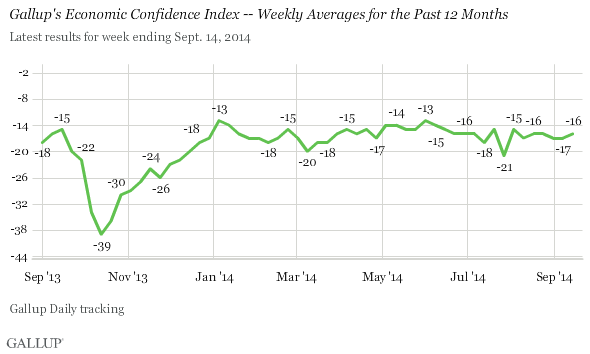WASHINGTON, D.C. -- Gallup's U.S. Economic Confidence Index measured -16 for the week ending Sept. 14, 2014. The index has stayed within one point of -16 for the past seven weeks.

The index has been -20 or lower only twice so far in 2014: in early March and again for a week in late July. It quickly recovered both times, reaching the -16 and -15 scores seen throughout 2014 within a few weeks of each dip. The average weekly index for 2014 is -16, the same as the most recent weekly index.
Gallup's Economic Confidence Index is the average of two components: Americans' views of current economic conditions and their opinions on whether the economy is getting better or worse. For the week ending Sept. 14, 19% of Americans said the economy was "excellent" or "good," while 35% said the economy was "poor." This resulted in a current conditions index score of -16, compared with -15 the week before.
Gallup's economic outlook score improved slightly. While 39% of Americans said the economy was "getting better," 55% said it was "getting worse." This resulted in an economic outlook score of -16, up from -19 the week prior.

Bottom Line
While economic confidence remains stable in the U.S., the current level is a noticeable improvement over the scores in the -40s and -50s seen through much of 2009 until 2011. The index has stayed within an eight-point range so far in 2014. This lack of variation between weekly index scores is unusual compared with prior years. Last year, weekly scores were within a 31-point range from January through September -- from a high of -3 in May to a low of -34 in the last week of September. And in 2009, in the depths of the recession, scores were within a 39-point range between January and the end of September, dropping to a low of -59 for two weeks in February but reaching a high of -20 in the second-to-last week of September.
The more stable economic confidence scores in 2014 are an improvement from the drastic drops seen in previous years, but also indicate that confidence is not growing. Americans remain more negative than positive about the current economy, and most think the economy will get worse in the future, indicating that Americans' pessimistic views of the economy persist.
Gallup.com reports results from these indexes in daily, weekly, and monthly averages and in Gallup.com stories. Complete trend data are always available to view and export in the following charts:
Daily: Employment, Economic Confidence and Job Creation, Consumer Spending
Weekly: Employment, Economic Confidence, Job Creation, Consumer Spending
Read more about Gallup's economic measures.
View our economic release schedule.
Survey Methods
Results for this Gallup poll are based on telephone interviews conducted Sept. 8-14, 2014, on the Gallup Daily tracking survey, with a random sample of 3,532 adults, aged 18 and older, living in all 50 U.S. states and the District of Columbia.
For results based on the total sample of national adults, the margin of sampling error is ±2 percentage points at the 95% confidence level.
Interviews are conducted with respondents on landline telephones and cellular phones, with interviews conducted in Spanish for respondents who are primarily Spanish-speaking. Each sample of national adults includes a minimum quota of 50% cellphone respondents and 50% landline respondents, with additional minimum quotas by time zone within region. Landline and cellular telephone numbers are selected using random-digit-dial methods. Landline respondents are chosen at random within each household on the basis of which member had the most recent birthday.
Samples are weighted to correct for unequal selection probability, nonresponse, and double coverage of landline and cell users in the two sampling frames. They are also weighted to match the national demographics of gender, age, race, Hispanic ethnicity, education, region, population density, and phone status (cellphone only/landline only/both, and cellphone mostly). Demographic weighting targets are based on the most recent Current Population Survey figures for the aged 18 and older U.S. population. Phone status targets are based on the most recent National Health Interview Survey. Population density targets are based on the most recent U.S. census. All reported margins of sampling error include the computed design effects for weighting.
In addition to sampling error, question wording and practical difficulties in conducting surveys can introduce error or bias into the findings of public opinion polls.
For more details on Gallup's polling methodology, visit www.gallup.com.
